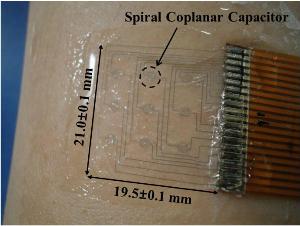Jun 25 2014
Can emotional states be measured quantitatively, and if so what would advertising, manufacturing and social media companies do with that data? Imagine a world in which a consumer's real-time physical and emotional response helped to determine his/her experience of music, online ads or the temperature in the room.
 The Goose Bump Detector: a skin piloerection monitoring sensor conformally attached to the dorsal forearm. Credit: Young-Ho Cho/KAIST
The Goose Bump Detector: a skin piloerection monitoring sensor conformally attached to the dorsal forearm. Credit: Young-Ho Cho/KAIST
That may not be so far away -- a team of researchers at KAIST in Daejeon, South Korea has developed a flexible, wearable 20mm x 20mm polymer sensor that can directly measure the degree and occurrence on the skin of goose bumps (technically known as "piloerection"), which is caused by sudden changes in body temperature or emotional states.
Described this week in the journal Applied Physics Letters, from AIP Publishing, the technology is based on an electronic device known as a coplanar capacitor and detects goose bumps by virtue of a simple, linear relation between the deformation of the sensor and the decrease of the capacitance.
“We found that the height of the goose bump and the piloerection duration can be deduced by analyzing obtained capacitance change trace,” explained Young-Ho Cho.
While more work still needs to be done to correlate such physical measurements with emotional states, the work suggests that quantitatively monitoring goose bumps in real-time as an indicator of human physical or emotional status is possible, which could pave the way for personalized advertising, music streams or other services informed by directly access to the emotions of the end user.
"In the future, human emotions will be regarded like any typical biometric information, including body temperature or blood pressure," Cho said.
How the Device was Made
Through use of microfabrication technology, Cho and colleagues built the sensor using a conductive polymer called PEDOT:PSS for the capacitors, which is flexibile compared to brittle metallic conductive materials. The capacitors were embedded in a silicon substrate via a multi-step spin-coating process, giving them a spiral shape and coplanar structure. This gave them high capacitive density and high deformability while remaining only 1.2 micrometers thick.
The silicon substrate, known as Ecoflex 0030, was selected due to its biocompatibility and high degree of flexibility relative to human skin. It is also highly thermal and photo-stability, which allows the embedded polymer devices to maintain their performance in diverse conditions.
They attached these sensors to the inside of a 28-year old subject’s dorsal forearm and had him grab ahold of ide cubes to induce a sudden cold shock. This stimulated piloerection, deforming the sensors and causing their capacitance to notably decrease.
Future work includes scaling down the signal processing module and capacitance measurement system to be co-mounted on skin with the sensor.
The article "A Flexible Skin Piloerection Monitoring Sensor" by Jaemin Kim, Dae Geon Seo, and Young-Ho Cho will be published in the journal Applied Physics Letters on June 24, 2014 (DOI: 10.1063/1.4881888). After that date, it can be accessed at: http://scitation.aip.org/content/aip/journal/apl/104/25/10.1063/1.4881888
ABOUT THE JOURNAL
Applied Physics Letters features concise, rapid reports on significant new findings in applied physics. The journal covers new experimental and theoretical research on applications of physics phenomena related to all branches of science, engineering, and modern technology. See: http://apl.aip.org